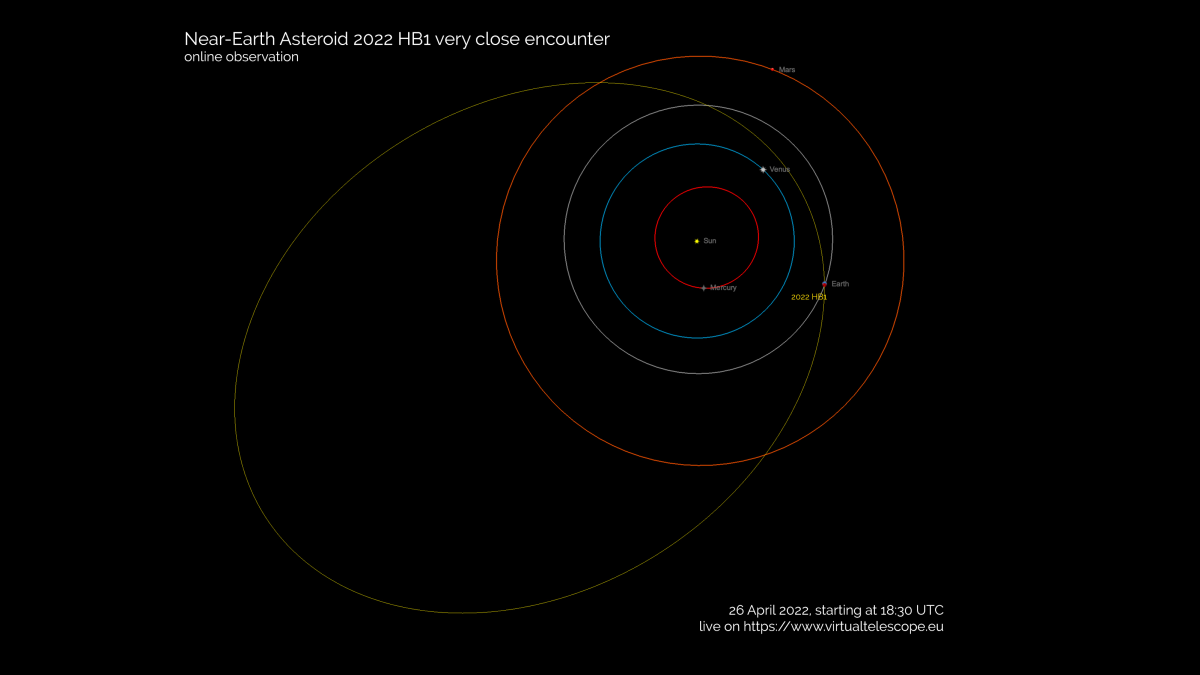Watch a bus-sized asteroid safely zoom past Earth within the moon's orbit
See live views of the asteroid 2022 HB1 at 2:30 p.m. EDT (1830 GMT) via the Virtual Telescope Project.
Anyone with a strong Internet connection can watch a bus-sized asteroid make a safe flyby of Earth today (April 26).
Weather permitting, the Virtual Telescope Project plans to livestream live telescopic views of the recently found asteroid 2022 HB1. The asteroid will pass within about 52% of the moon's orbit. The broadcast starts at 2:30 p.m. EDT (1830 GMT) and you can watch it in the video feed above or directly from The Virtual Telescope Project.
The asteroid is roughly 39 feet wide (12 meters), making it roughly the size of a bus, according to NASA's Jet Propulsion Laboratory. The little world will pass within 125,000 miles (201,000 km) of our planet.
Related: The greatest asteroid missions of all time!

The Mount Lemmon Survey, a part of the Catalina Sky Survey, discovered the asteroid on Sunday (April 24) and made an announcement that day via an International Astronomical Union Minor Planet Center bulletin.
The asteroid is too small to be deemed "potentially hazardous"; that designation requires that an asteroid be larger than 492 feet (150 meters), many times larger than 2022 HB1. The little asteroid does firmly meet the distance qualification: potentially hazardous asteroids must pass within 4.6 million miles (7.5 million kilometers or 19.5 times the distance to the moon) of Earth.
NASA has found no imminent threats to date after decades of scanning the sky, but the agency continues to watch out for asteroids through partner telescopes and space observations, coordinated through the Planetary Defense Coordination Office.
Breaking space news, the latest updates on rocket launches, skywatching events and more!
The agency also tests asteroid defense procedures. A notable example is the 1,210-pound (550 kilograms) DART spacecraft, which should slam into a small asteroid (Dimorphos) in September or October. If all goes to plan, the mission will change the orbit of this asteroid around its larger companion, Didymos.
If you're looking for a telescope or binoculars to spot asteroids like this one, check out our guide for the best binoculars deals and the best telescope deals available now. Our best cameras for astrophotography and best lenses for astrophotography can also help you pick the best imaging gear.
Follow Elizabeth Howell on Twitter @howellspace. Follow us on Twitter @Spacedotcom and on Facebook.
Join our Space Forums to keep talking space on the latest missions, night sky and more! And if you have a news tip, correction or comment, let us know at: community@space.com.

Elizabeth Howell (she/her), Ph.D., was a staff writer in the spaceflight channel between 2022 and 2024 specializing in Canadian space news. She was contributing writer for Space.com for 10 years from 2012 to 2024. Elizabeth's reporting includes multiple exclusives with the White House, leading world coverage about a lost-and-found space tomato on the International Space Station, witnessing five human spaceflight launches on two continents, flying parabolic, working inside a spacesuit, and participating in a simulated Mars mission. Her latest book, "Why Am I Taller?" (ECW Press, 2022) is co-written with astronaut Dave Williams.
